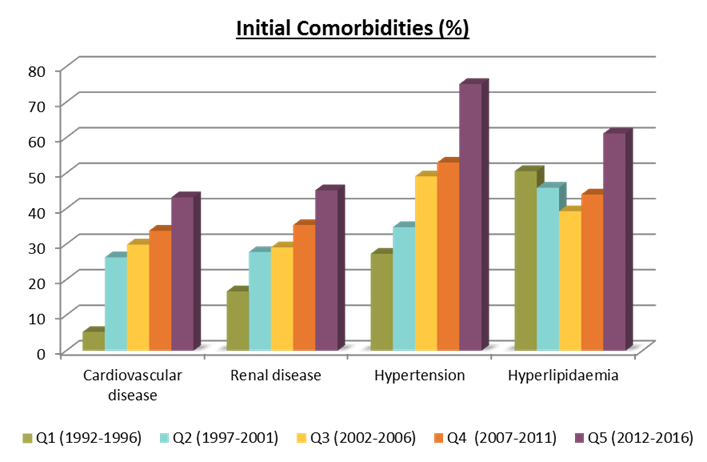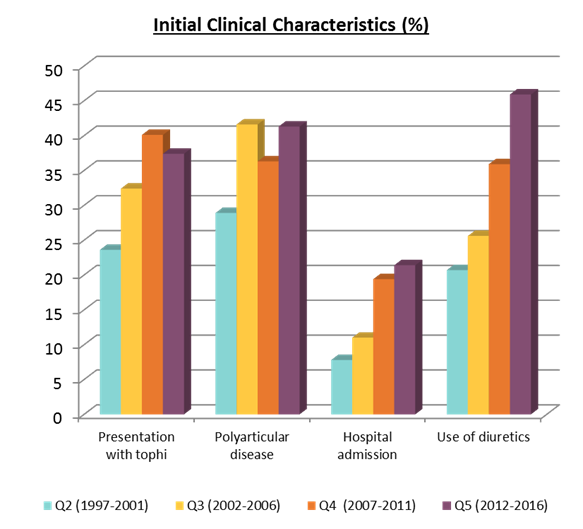Session Information
Session Type: ACR Poster Session B
Session Time: 9:00AM-11:00AM
Background/Purpose: Gout is a rising cause of hospital admissions and emergency consults. It has even replaced rheumatoid arthritis as the principal rheumatological condition causing hospitalizations. Some questions arise in this setting: What are the characteristics of our patients? How have they changed over the past years? Our objective is to analyze possible changes in the clinical profile of gout patients during a period of 25 years.
Methods: Data was collected from a prospective cohort of gout patients, from a crystal arthritis clinic in a tertiary hospital (reference population: half a million inhabitants). The period, between 1992 and 2016 (n = 1137) was reviewed, with division into five quinquennia (Q). All patients fulfilled ACR/EULAR 2015 gout classification criteria. When entering the cohort, epidemiologic, clinic, laboratory and imaging data are systematically collected. Variables susceptible to change in time were considered: age, gender, gout clinical data, previous admissions due to gout and comorbidities. Complex patients were defined as those who presented at the first visit with polyarticular disease and/or tophi plus chronic kidney disease and/or cardiovascular disease. Quantitative variables were analyzed with ANOVA and Bonferroni correction; qualitative variables with chi-square test. Inclusion of patients to the cohort was approved by the hospital ethics committee. Data from extreme quinquennia are reported (1stQ: 1992-1996 / 5thQ 2011-2016 or 2ndQ: 1997-2001 / 4th: 2006-2010). All results are statistically significant unless stated otherwise.
Results: Differences were observed regarding age at first visit (1stQ: 54.1 ± 10.9 / 5thQ: 64.6 ± 13.8 years) and gender (1stQ: 2.6% / 5thQ: 12.2% of women, respectively).
Initial comorbidities: See graph 1.
Initial clinical characteristics: See graph 2
The overall prevalence of complex patients was of 67.1%, with increasing incidence through time (1stQ: 53.9% / 5thQ: 77.1%). Globally, less than half of these patients (39.7%) had received urate lowering treatment prior to their first visit.
Conclusion: The profile of gout patients has notably changed in the past 25 years: we have elder, more complex patients, with higher rates of hospital admissions, with severe forms of disease and important comorbidities. Nevertheless, most of these complex patients have not been appropriately started on urate lowering therapy. When considering these results, we believe that a substantial proportion of gout patients will require specialized attention in the coming years.
To cite this abstract in AMA style:
Chinchilla S, Urionagüena I, Perez-Ruiz F. Are We Ready? Changes in the Profile of Gout Patients over the Last 25 Years [abstract]. Arthritis Rheumatol. 2017; 69 (suppl 10). https://acrabstracts.org/abstract/are-we-ready-changes-in-the-profile-of-gout-patients-over-the-last-25-years/. Accessed .« Back to 2017 ACR/ARHP Annual Meeting
ACR Meeting Abstracts - https://acrabstracts.org/abstract/are-we-ready-changes-in-the-profile-of-gout-patients-over-the-last-25-years/


